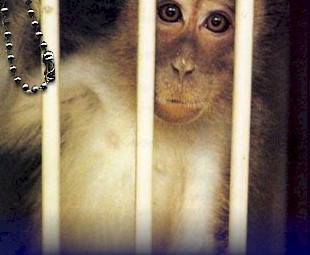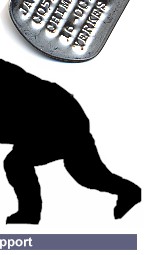






|
||||||||||||||||||||||||||||||||||||||||||||||||||||||||||||||||||||||||||||||||||||||||||||||||||||||||||||||||||||||||||||||||||||||||||||||||||||||||||||||||||||||||||||||||||||||||||||||||||||||||||||||||||||||||||||||||||||||||||||||||||||||||||||||||||||||||||||||||||||||||||||||||||||||||||||||||||||||||||||||||||||||||||||||||||||||||||||||||||||||||||
The UCLA-VA Vervet Monkey Research Colony University of California Los Angeles Vervet #1984-016 This is Alani's story, ID #1984-016 at UCLA
I also have the Primate Freedom Tag for Pricilla #27276, who was living at UC Davis (http://www.primatefreedom.com/tagreports/27276.html). The response I got from UC Davis was very thorough, including many pages of laboratory records, which detailed Pricilla's life and what was done to her while she was at UC Davis. The response I got from UCLA was a short, one page letter that tells about her life, but does not go into detail, as the lab reports would show. That is why I don’t have all the information I would like to have to write her story, so I have to go with what I have received from UCLA. I have no idea about Alani’s offspring, what date she was brought to (or born at) UCLA, or any other further info except what it here. I will try to get in touch with UCLA further and if I am successful on obtaining her lab records, I will update her story with that infomation. Alani is alive and well and is 19 years old. She is used in a NIMH sponsored research project on behavioral genetics of impulsivity. Her role in this "research" is observational on genetic and maternal influences on the development of individual differences in behavioral traits. She is living in a stable social group with 15 other animals, including four adult males, six other females and their five offspring. The adult males of the group are now vasectomized to limit population growth. The group is housed in a large outdoor pen. Enrichment includes continuous access to social companions, stimulation from the outdoor environment, and provision of natural objects for manipulation. She also gets daily supplementation with seasonal fresh produce. Alani's future plans are for her to continue to live in her home group as long as her health permits. Being that she is 19 years old, she has already lived longer than most Vervets would in the field. Some background information on Vervet's: The average body mass for an adult male Vervet monkey is around 5 kilograms, and for a female it is around 3.5 kilograms. On the abdomen the skin of both sexes is blue. Both males and females have long, sharp canines. The Vervet Monkey is found throughout Southern, Eastern, and Western Africa. This species prefers to live in riverine woodland, although it is highly adaptable and can live in a variety of habitats even living amongst humans. The Vervet monkey moves both on the ground and in the trees. This species only occasionally leaps from tree to tree. This species descends trees in a head first manner. The fastest mode of locomotion is a bounding gallop on all of its limbs. The Vervet monkey is capable of swimming. Spy hopping is a locomotory pattern that is used when the Vervet monkey is traveling in tall grass, which restricts its vision. When the Vervet monkey runs it will hop on its hind legs to see over the tall grass. The Vervet monkey has a multimale-multifemale social system. Males are forced to emigrate upon the onset of puberty when their genitalia begins to turn color. Females in the group form a linear dominance hierarchy with the daughters inheriting their rank from their mothers. High-ranking individuals have a priority access to food resources. Adult females of a group mainly interact with close relatives. Both sexes are territorial. Juvenile males will hold and care for infant siblings, but adult males generally show no interest in infants. Mothers will let other females handle her infants. Females tend to favor handling of infants belonging to higher-ranking individuals. Grooming is an important social behavior that reinforces social bonds. The Vervet monkey gives birth to a single offspring. Until the day that all animals are free from exploitation, we must educate everyone about the lives these animals endure, whether it is in a laboratory, factory or fur farm, circus, or any other company that puts profit before animals. One of my favorite quotes: "Until he extends the depth of his compassion to all living things, man himself will not find peace" -Albert Schweitzer This is for all the animals that have suffered or are suffering now; there are compassionate people out here that care about you and are trying to make a difference for you and other animals! - Kiayanna Eichert 1984-016
Home Page | Our Mission | News |